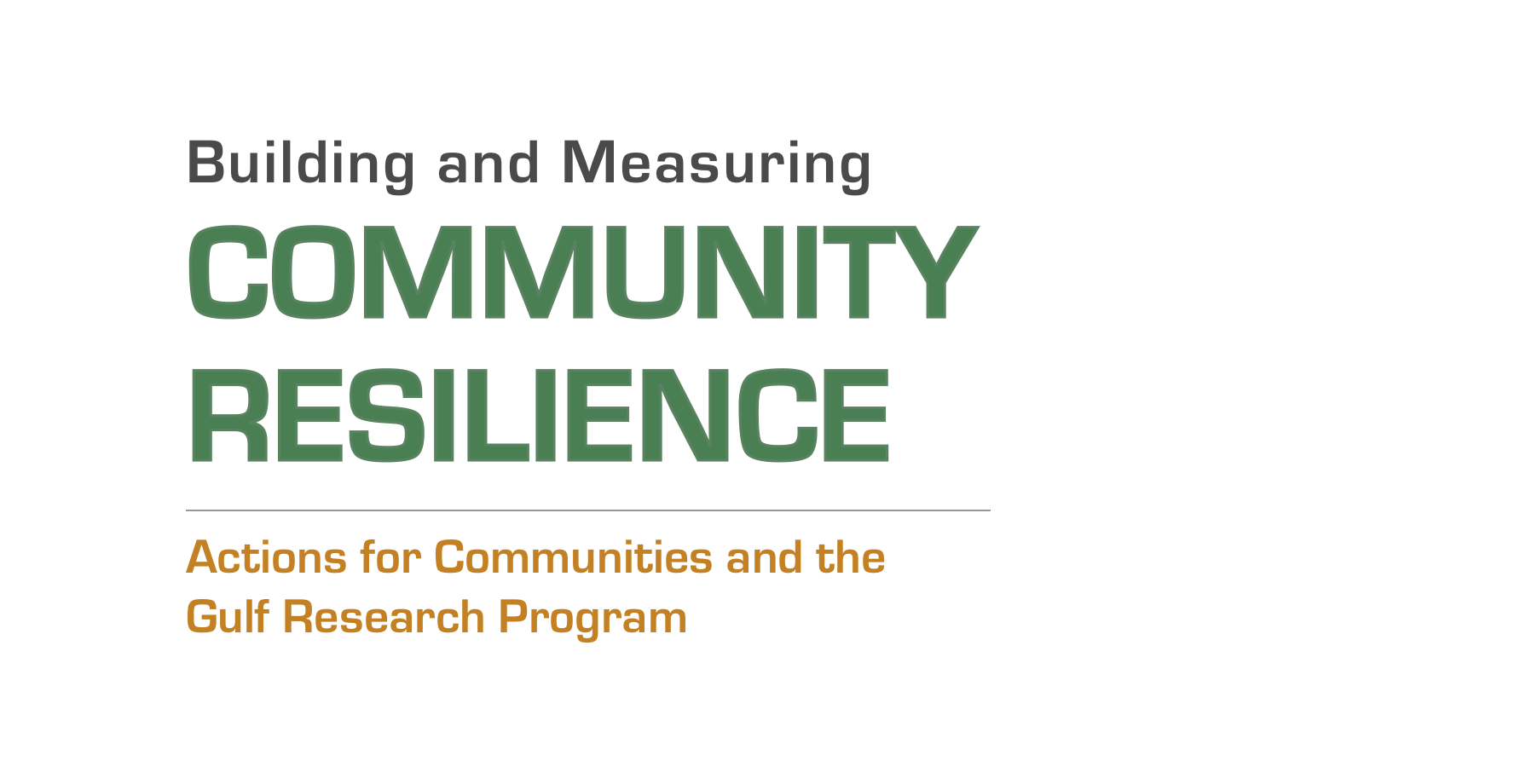

The frequency and severity of disasters over the last few decades have presented unprecedented challenges for communities across the United States. In 2005, Hurricane Katrina exposed the complexity and breadth of a deadly combination of existing community stressors, aging infrastructure, and a powerful natural hazard. In many ways, the devastation of Hurricane Katrina was a turning point for understanding and managing disasters, and it brought the phrase "community resilience Community resilience is “community capabilities that buffer it from or support effective responses to disasters."" into the lexicon of disaster management.
Over the past several years, many cities have been or are creating resilience offices and programs, and many regions are organizing around resilience and leveraging resources and partnerships. Within the context of this broader landscape of activity, questions arise about how or whether resilience has increased, whether investments are providing adequate returns, and how decision makers can begin to understand the impact that hazard mitigation, climate adaptation, and other resilience actions are having across numerous areas of community wellbeing.
The National Research Council’s 2012 report Disaster Resilience: A National Imperative noted that measuring Measurement is the act of assessing an object, event, or place using a reasonable and accepted standard measure (or metric) in order to compare the object, event, or place to itself at another time or in another condition, or to another object, event, or place. progress toward resilience
Resilience is "the ability to prepare and plan for, absorb, recover from, and more successfully adapt to adverse events" (from Disaster Resilience: A National Imperative, 2012, p. 1).
is important for building national resilience to disasters. Building resilience is a process that requires periodic measurement to assess progress toward resilience goals and ensure those goals are being met. However, many communities are not measuring their resilience.
The Committee on Measuring Community Resilience examined a sample of 33 resilience measurement efforts to better understand the current state of resilience measurement science and practice. The large number and variety of resilience measurement efforts underscores the fact that no single measurement tool fits the resilience measurement needs of all communities.
A defining characteristic of community resilience is multidimensionality; in other words, the resilience of a community encompasses all of the resources and assets available in the community.
The most common types of community dimensions—also known as "capitals"—include:






The committee found that few measurement efforts consider all of the six commonly used community dimensions or capitals. Gaps in coverage of all six community capitals limit a resilience measurement effort’s robustness in measuring the holistic nature of community resilience.
In addition, few measurement efforts have been applied more than once in the same community or in more than one community. Thus, resilience measurement science and practice are not mature enough to clearly articulate which resilience measurement approach is best or works best in practice.
The committee conducted meetings and site visits in eight communities and met with leading experts, decision makers, community leaders, and practitioners in local government, the private sector, the nonprofit sector, research centers, and academic institutions. The purpose of these visits was to learn about resilience measurement activities taking place in communities.
FIGURE 3-1 Map of the United States marking the location of each community with whom the committee met.
The community visits revealed that despite the range of available resilience measurement frameworks and tools, many communities are not measuring their resilience. In addition, because communities differ with respect to their challenges, goals and priorities, risk profiles and hazards, where they focus their resilience-building efforts, and how they implement resilience activities, there is not a one-size-fits-all approach to resilience practice and measurement given the diversity of communities.
The process of measuring resilience can provide community leaders and members information to help prioritize investments, allocate limited resources, and target the most effective programs and policies to mitigate the effects of shocks and stressors. It helps communities know how or whether their resilience has increased, whether their investments are providing adequate returns, and how their hazard mitigation, climate adaptation, and other resilience-related activities are impacting community wellbeing.
There are many frameworks and tools available to communities that purport to measure community resilience, though none of them are a silver bullet for resilience measurement. Despite this range of available tools, many communities lack the resources (e.g., time, staff, funds) to implement resilience measurement and do not devote resources to explicitly measure resilience. And, communities continue to express uncertainty about what they should measure, what measures to use, or even how to start the resilience-building process.
The large number of resilience measurement efforts available and the paucity of use of those tools reveal a gap between research on and the implementation of resilience measures. What can communities do to bridge this gap?
The process of participation helps communities develop resilience goals and priorities and generate community buy-in for those goals. Setting goals and priorities is necessary before any measurement activities can take place, as they provide the basis against which a community can track its progress and gauge its success.
Community dimensions are captured by the six capitals (i.e., natural, built, social, financial, human, and political), which provide a structure for setting community resilience goals and a reference for measuring progress toward those goals.
The data collected should be used to make decisions about public sector budgets and public-private financing, to gauge the efficacy or progress of resilience goals, or to inform policy formulation and implementation.
Community resilience investments can include milestones and yield multiple benefits that are trackable along and across the relevant community capitals. Measurement needs to include a range of downstream or cascading impacts of investment choices in order to capture the broadest range of multiple benefits.
The committee’s task was to provide recommendations on "key issues for future programs to consider in measuring the resilience of a community," which it interpreted as future programs the Gulf Research Program (GRP) would administer. In 2013, the National Academy of Sciences received $500 million in settlement funds from the Deepwater Horizon criminal cases and created the Gulf Research Program (GRP) to carry out the mission to improve understanding of the region’s interconnecting human, environmental, and energy systems and foster benefits for Gulf communities, ecosystems, and the nation.
The basic structure of a GRP community resilience initiative should include multiple communities, capture and document community resilience strategies and measurements, foster interactions across and among GRP resilient communities through a resilience learning collaborative, and implement longitudinal research that includes systematic analysis and integration of data from various sources.
View Figure 5-1: A GRP resilience initiative should include multiple communities across the Gulf region’s five states and take a nested approach, operating at three levels: within a community, across communities, and over multiple years.
Long-term, periodic, comprehensive resilience assessment research is needed that can address the dynamic state of communities and their changes in risk and resilience over time; link information or data from disparate programs with each other and to community resilience priorities; and ultimately link research, data, and information with decision making.
COMMITTEE MEMBERS
Adm. Thad Allen (Co-Chair)
Senior Executive Advisor
Booz Allen Hamilton
Dr. Gerald E. Galloway, Jr. (Co-Chair)
Glenn L. Martin Institute Professor of Engineering
University of Maryland, College Park
Dr. Michael Beck
Research Professor, Institute of Marine Sciences
University of California, Santa Cruz
Dr. Anita Chandra
Vice President and Director, Social and Economic Well-Being
RAND Corporation
Ms. Erin Coryell
Program Officer
Margaret A. Cargill Philanthropies
Dr. Susan Cutter
Carolina Distinguished Professor of Geography
University of South Carolina
Dr. Ann-Margaret Esnard
Associate Dean for Research and Strategic Initiatives, Office of the Dean, Andrew Young School of Policy Studies
Georgia State University
Dr. Howard Frumkin
Head of Our Planet, Our Health
Wellcome Trust
Dr. Melanie Gall
Research Professor, Emergency Management and Homeland Security Program
Arizona State University
Dr. Maureen Lichtveld
Professor and Chair, Freeport McMoRan Chair of Environmental Policy
Tulane University School of Public Health and Tropical Medicine
Dr. Carlos Martín
Senior Fellow, Metropolitan Housing and Communities Policy Center
Urban Institute
Mr. Chris Poland
Consulting Engineer
Chris D Poland Consulting Engineer
Dr. Liesel Ritchie
Associate Professor, Department of Sociology
Oklahoma State University
Dr. Kathryn Sullivan
Senior Fellow
Potomac Institute for Policy Studies